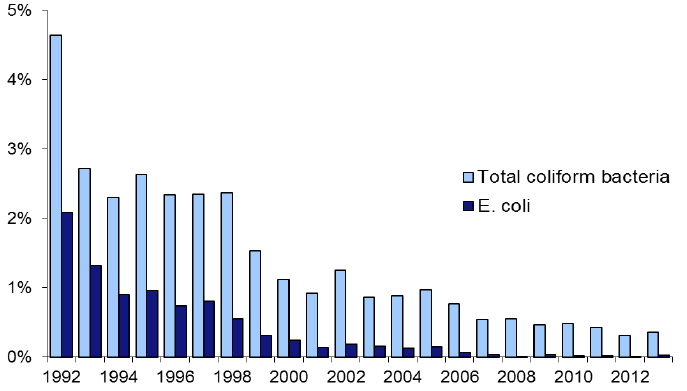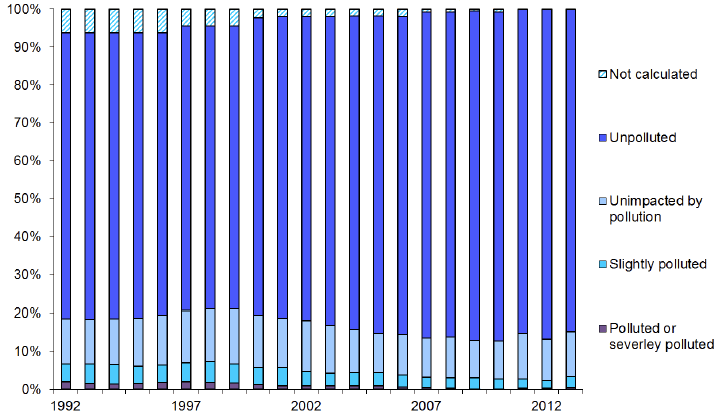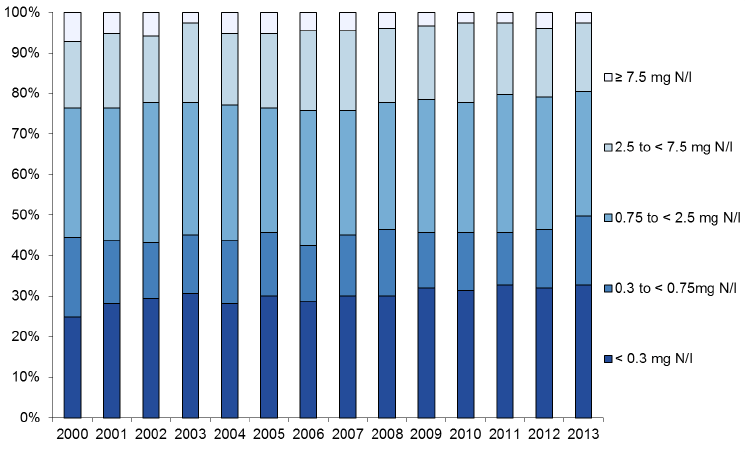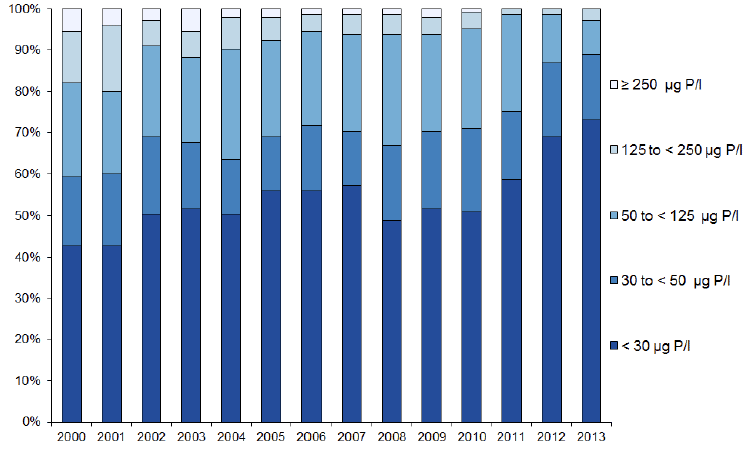Key Scottish Environment Statistics 2014
This publication aims to provide an easily accessible reference document which offers information on a wide range of environmental topics. It covers key datasets on the state of the environment in Scotland, with an emphasis on the trends over time wherever possible. The data are supplemented by text providing brief background information on environmental impacts, relevant legislation and performance against national and international targets.
This document is part of a collection
Water
Public Water Supplies - Water Abstracted and Supplied[1],[2],[3],[4]: 2002/03-2013/14
Million litres per day (Ml/d)
![Public Water Supplies - Water Abstracted and Supplied[1],[2],[3],[4]: 2002/03-2013/14 Public Water Supplies - Water Abstracted and Supplied[1],[2],[3],[4]: 2002/03-2013/14](/binaries/content/gallery/publications/statistics/2014/08/key-scottish-environment-statistics-2014/00459288.gif)
For sustainable management of water resources, it is essential to meet consumers' demands and standards, whilst maintaining aquatic ecosystem health. Abstraction of water has impacts on geology, habitats, wildlife, biodiversity and recreational use of water resources. This is being managed by Scottish Water and Scottish Environment Protection Agency under the Water Resource Planning and River Basin Management Planning Processes.
Between 2002 and 2009, estimated raw water abstractions by Scottish Water decreased by 13% to 2,165 Ml/d. Between 2010 and 2013, using improved data and methodology, the volume of raw water abstracted also decreased by 11% to 1,870 Ml/d.[1],[2]
Between 2004/05 and 2013/14, treated water produced[3],[5] fell by 554 Ml/d (23%) to a new low of 1,824 Ml/d. This decrease in treated water is almost entirely due to a reduction in leakage[6] of 531 Ml/d (47%) to 608 Ml/d over the same period. The Economic Level of Leakage (ELL) (where the cost of repair is greater than the value of water leaking from the system) was attained in 2012/13, and Scottish Water continues to manage leakage at the ELL.
Operational use[7] increased by 53 Ml/d between 2002/03 and 2007/08 to a peak of 71 Ml/d. It has since decreased by 28 Ml/d to 43 Ml/d in 2013/14. Domestic water consumption has increased by 8% between 2002/03 and 2013/14 whereas non-domestic water consumption has decreased by 21% over the same period. However, when looking at all water consumption combined (operational use, domestic and non-domestic consumption), there has been relatively little change over the whole period.
Source: Scottish Water / Metadata
Drinking Water Quality: 1992-2013
Percentage of samples at consumers' taps containing coliform bacteria

The coliform group of bacteria is present in large numbers in the gut of all warm-blooded animals and is also widely distributed in the environment. Their presence in tap water indicates a breach in the integrity of the water supply system.
Scottish Water is required to analyse samples taken from water treatment works, service reservoirs and consumers' taps. The Water Supply (Water Quality) (Scotland) Regulations 2001[8] set strict standards for compliance for a wide range of parameters. The major centres of population in Scotland are served by modern water treatment works, which are all well equipped to achieve the required standard. In recent years, many improvements have been made to most of the small, rural treatment works, that have historically been unable to consistently and satisfactorily treat water to the standard required by the Regulations.
Samples containing coliform bacteria fail to meet the water quality standards. Between 1992 and 2013, the percentage of samples from consumer taps containing coliform bacteria fell from 4.64% to 0.35% and the percentage containing Escherichia coli (E.coli) fell from 2.08% to 0.02%. Most of this improvement is the result of investments made at water treatment works across the country over the past ten years. Between 2012 and 2013 the failure rate for total coliforms increased by 0.04 percentage points while the failure rate for E. coli increased by 0.02 percentage points.
Source: Drinking Water Quality Regulator For Scotland / Metadata
River Water QualityR: 1992-2013
Distribution of river water quality, percentage of river length within each band

Low standards of river water quality may threaten the aquatic environment, drinking water quality and recreational water use. Sewage, industry, urban development and agriculture are some of the factors that can affect river water quality.
The Scottish Environment Protection Agency (SEPA) has established an indicator of river water quality based on a network of sites covering 253 water bodies (rivers or sections of rivers), which account for approximately 10% of all water bodies. The indicator is based on a consistent set of five water quality parameters which are sensitive to organic pollution, nutrients and toxic substances and provide a measure of species diversity. Each of the parameters is assessed over a rolling 3 year period and the results weighted by river length. The assessment is against the standards provided for each parameter in the Water Framework Directive classification.[9]
In this indicator, river water quality is classified as 'unpolluted', 'unimpacted by pollution', 'slightly polluted', 'polluted', or 'severely polluted'. Between 1992 and 2013, the proportion of river length for which river quality could not be calculated fell from 6.2% to zero. Most of these water bodies were subsequently classed as 'unpolluted' or 'unimpacted by pollution'. The proportion of river length that was classed as slightly polluted, polluted or severely polluted in Scotland rose from 6.8% in 1992, to 7.4% in 1998, before falling to 2.3% in 2012 but rising to 3.4% in 2013. The main drivers of slightly polluted, polluted and severely polluted rivers are inputs of nutrients, leading to degraded biological and nutrient quality. The proportion of river length classed as unpolluted rose from 85.7% in 2007 to 86.5% in 2010. This has since fallen to 84.8% in 2013. The length of river classed as unimpacted by pollution fell from 12% in 2011 to 11.8% in 2013.
Source: Scottish Environment Protection Agency / Metadata
Nitrate Concentrations in Rivers: 2000-2013
Distribution of mean nitrate concentrations, percentage of sites[10] within each band

The enrichment of waters by nutrients, such as nitrates and phosphates, may lead to the damage of the aquatic environment through a process called eutrophication. The increase in nutrients causes accelerated growth of algae and other plant life. This rapid growth and subsequent decay of plant organisms depletes oxygen levels, which can have harmful effects upon fish and other aquatic life which require oxygen to survive.
High nitrate levels tend to have a greater impact on marine and coastal waters than on freshwater; however, a substantial part of the nitrates in freshwater will eventually reach the sea. The main source of nitrates in freshwater is agriculture.
To provide a consistent time series, allowing trends to be measured, the chart is based on concentrations at the 153 sites where four or more samples per year have been taken each year since 2000.
Concentrations of nitrate below 0.3 mg N/l are considered to be natural or background levels[11]; over 30% of the sites have met this classification between 2007 and 2013. The percentage of sites with mean nitrate concentrations of < 0.3 mg N/l has increased from 25% in 2000 to 33% in 2013. In 2013, less than 3% of sites had nitrate concentrations over 7.5 mg/l compared with over 7% in 2000.
Regulations have been made designating 14% of the area of Scotland[12] as Nitrate Vulnerable Zones (NVZs).[13] In NVZs, mandatory rules on farming practices aim to reduce nitrate water pollution from agricultural sources.
Source: Scottish Environment Protection Agency / Metadata
Orthophosphate Concentrations in Rivers: 2000-2013
Distribution of mean orthophosphate concentrations[14], percentage of sites within each band

Raised levels of orthophosphate in freshwaters may lead to eutrophication. The main source of phosphorus is diffuse pollution from agriculture, but there is also a risk that discharges from waste water treatment works contain phosphates.
To provide a consistent time series, allowing trends to be measured, the chart is based on concentrations at the 145 sites where four or more samples per year have been taken each year since 2000.
Between 2000 and 2013, the percentage of sites with orthophosphate concentrations less than 30 μg P/l increased from 43% to 73%, while the percentage of sites with concentrations in excess of 125 μg P/l fell from 18% to 3% over the same time period. These changes over the time series in part reflect the improvements in water quality following the investments made to the sewage infrastructure in Scotland.
Under the Urban Waste Water Treatment Directive (UWWTD) (91/271/EEC), catchments where nutrient levels are considered to be high are designated as sensitive areas. Discharges into waters that have been designated as sensitive require additional treatment to remove nutrients.
Contact
Email: Kirsty Ciclitira
There is a problem
Thanks for your feedback